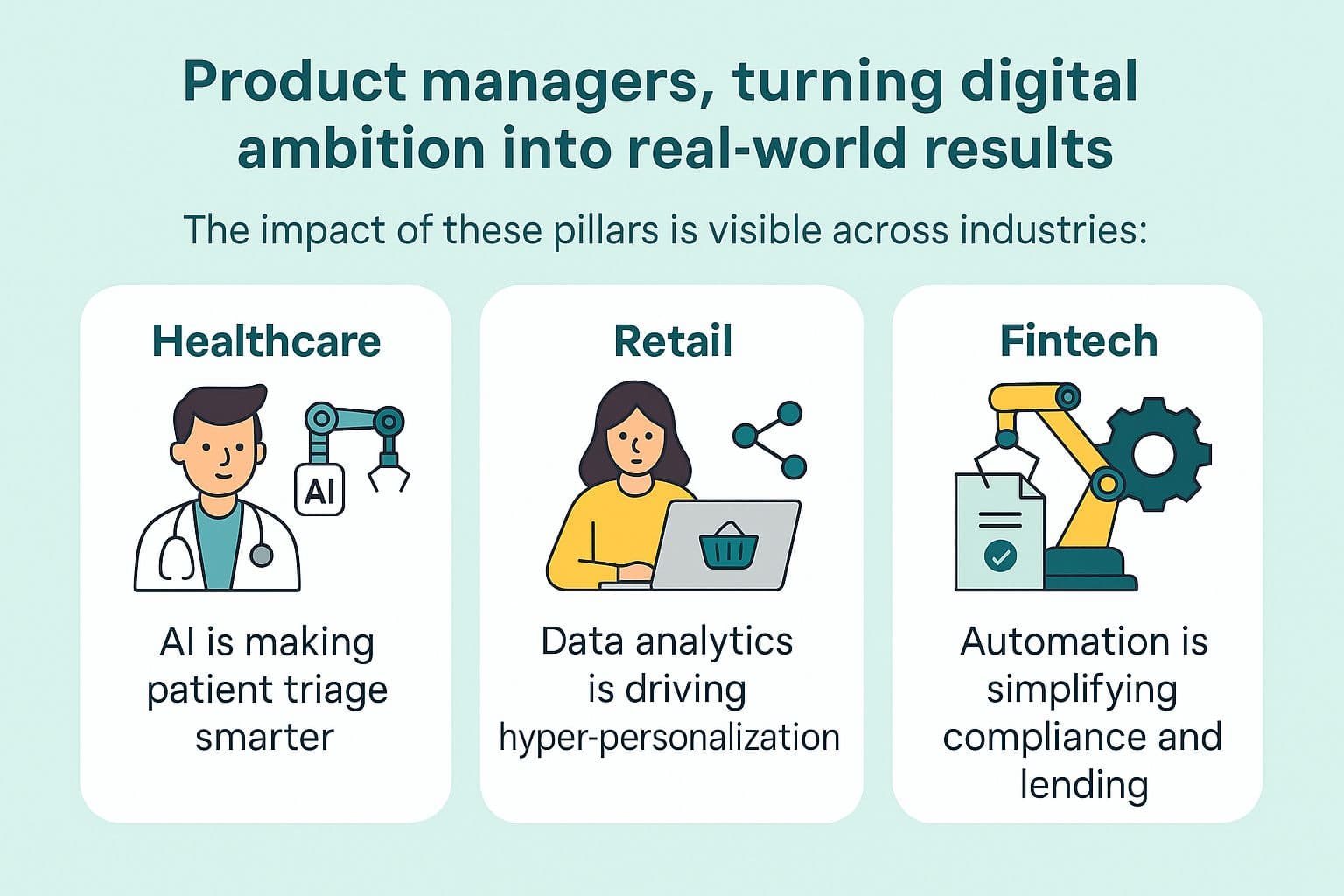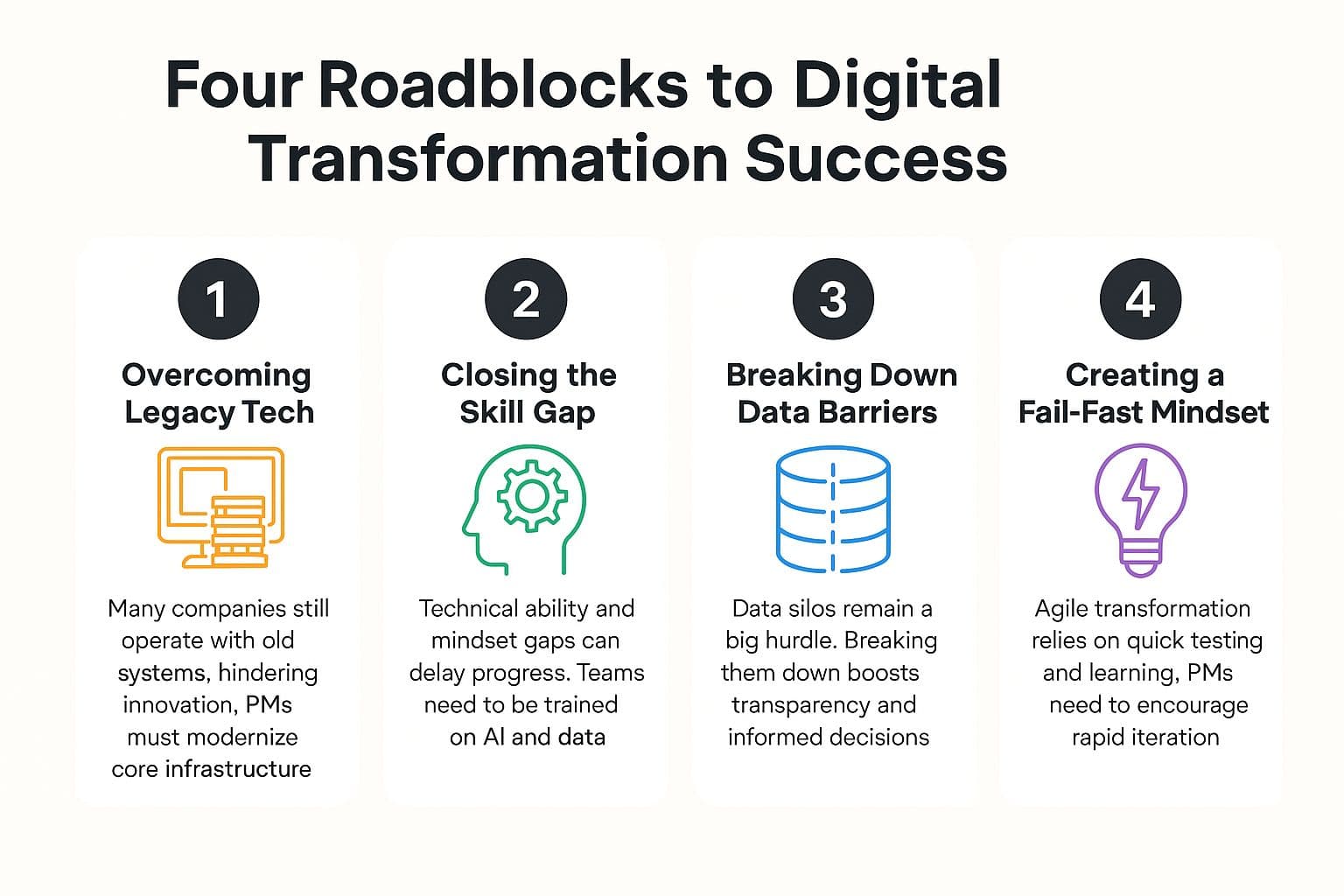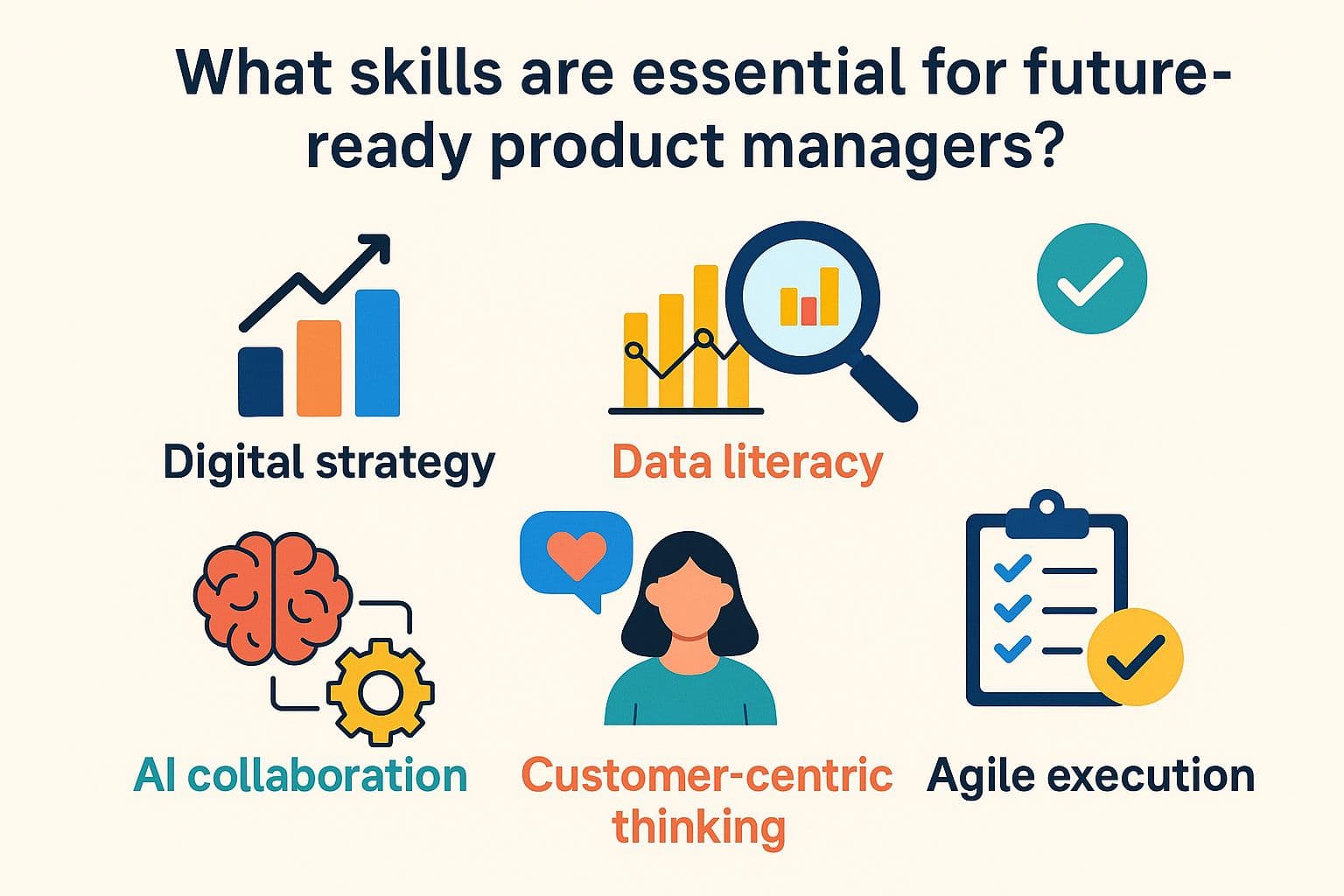The Digital Shift Starts Here: Inside the Product Manager’s Role

Every company wants to go digital, but product managers are the ones making it happen. As AI, cloud, and data reshape industries, PMs now sit at the intersection of strategy, technology, and customer value. According to IDC, 91% of companies have ranked digital transformation strategies as their top priority. Additionally, Grand View Research states that the market is likely to be worth $4.6 trillion by 2030; thus, the competition for a digital enterprise capable of facing the future has become incredibly intense.
Also, Digital Transformation Product Management is one of the most important areas of growth in professional development and skills. Product management is no longer limited to the execution of roadmaps; it is now the strategic nucleus of digital product management, where the technology, business objectives, and customer experiences are brought together by the leaders to create value.
Explore how product managers are at the forefront of digital transformation, the product strategy details, and global digital transformation trends that are changing industries. This blog explores how digital transformation is redefining product management and which 2025 trends matter most.
What Digital Transformation Really Means for Modern Businesses?

Digital transformation isn’t just about how organisations adopt new tech; it’s about rethinking how a business creates and delivers value. Yet, according to Deloitte, 70% of digital projects fail due to weak strategy or poor leadership alignment.
True transformation rests on four key pillars that define modern success:
- Agility – Fast and smooth adaptation to market changes and disruptions.
- Customer experience – Putting user-centricity at the heart of innovation.
- Data-driven decisions – Converting insights into smarter and quicker outcomes.
- Tech integration – Guaranteeing smooth collaboration between digital ecosystems.
The impact of these pillars is visible across industries. In healthcare, AI is making patient triage smarter; in retail, data analytics is driving hyper-personalization; and in fintech, automation is simplifying compliance and lending. At the heart of all this progress are product managers, turning digital ambition into measurable results.
What separates successful digital transformations from stalled ones is the ability to align people, processes, and platforms around a shared vision. It’s not about chasing every new technology trend; it’s about using the right tools to solve the right problems. That’s where modern product managers play a game-changing role.
They bridge the gap between leadership goals and on-ground execution, ensuring every decision is backed by data and every initiative ties back to user value. With smart analytics, automation, and cross-functional collaboration tools, they turn complexity into clarity. The outcome? Faster product cycles, more connected teams, and businesses that don’t just adapt to the digital age, but define it.
Also Read: 12 Digital Transformation KPIs and Metrics to Track in 2025
The Role of Product Managers in Driving Digital Transformation Success
Product Management in Digital Transformation has turned into a key factor for the success of organisations in the current digital-driven economy. According to Gartner, 58% of organisations now rely on product managers to lead digital transformation. You’re no longer just a roadmap owner; you’re a change architect, aligning digital strategy with customer impact every step of the way.
Also, modern product managers first align the transformation initiatives with the measurable outcomes. They even make sure that every digital effort actually creates value for the users and the business.
To sum up, product managers play a major part in driving digital transformation by converting expectations into tangible outcomes using empathy, analytics, and foresight as their main tools to craft the future-ready digital enterprises. This not only survives but thrives in the midst of rapid digital transformation trends.
In short, PMs bridge ambition and execution, translating vision into the outcomes that move both users and businesses forward.
Ready to Win the Digital Game? Here’s the New Product Strategy That Works

In the era characterised by AI, automation, and cloud computing innovations, a digital transformation product strategy has turned out to be a dynamic process that is user-driven, adaptive, and continuous. McKinsey's report indicates that companies with digital capabilities get 23% more profit than their competitors, which clearly demonstrates that the ability to adjust quickly is the new competitive edge in managing digital products.
1. Continuous Discovery Keeps You Ahead
The digital product teams have totally changed their attitude towards long release cycles. Also, Continuous discovery keeps teams user-focused, cross-functional models break silos, and cloud-native architectures scale innovation.
2. Collaboration That Breaks Silo
Digital Transformation Product Management is successful due to the cooperation of engineering, design, marketing, and analytics teams.
3. Scaling Faster with Cloud-Native Power
Cloud-native architectures give digital product managers the power to innovate at the same time and with the same volume.
How are Smart Tools Changing The Way Product Managers Work Today?
Product management has come a long way. Today, it’s not just about intuition or experience, it’s powered by smart tools that connect the dots between strategy, execution, and analytics.
Modern product managers have an entire ecosystem at their fingertips. From tracking progress and aligning roadmaps to measuring impact and collaborating across teams, these tools have turned product management into a data-driven, insight-rich practice.
What this really means is that decisions are sharper, teams move faster, and products evolve with real clarity, because the right tools make every step of the journey visible, measurable, and actionable.
1. Product & Project Management Tools
Jira, Trello, and Asana are some of the platforms that come to the rescue of PMs in managing and organising backlogs through fetching features. Along with the rest digital operations get done without a hitch. Besides, these tools are vital in making the digital transformation product strategy into actionable deliverables.
2. Collaboration & Design Tools
Miro, Figma, and Notion are the tools that have made cross-functional collaboration easier by facilitating the creation of shared mental models, mapping out processes, and even keeping the entire engineering, design, and marketing teams in the loop.
3. Analytics & Insight Platforms
The core of product managers driving digital transformation is the implementation of data-driven decision-making. Amplitude, Mixpanel, and Tableau are some of the tools that work as enablers for the PMs to keep track of KPIs, study user behaviour, and test product hypotheses live.
The PMs not only increase productivity by adding these tools to their daily routine but also lay the ground for digital enterprises that are ready for the future, thus further allowing the uninterrupted flow of innovation, data-informed strategies, and smooth execution of digital transformation trends.
The Roadblocks Every Digital Product Manager Must Overcome
Despite the increasing technology investments, those who lead digital transformation still experience a distinct set of challenges that put their strategies and execution to the test. PwC reports that 45% of leaders cite legacy tech, 37% mention culture or skill gaps, and 33% face data integration issues.
1. Overcoming Legacy Tech
A lot of companies are still operating with old systems, which are a big hindrance to coming up with new and better ways of doing things. Also, PMs must collaborate closely with IT and engineering to modernise infrastructure and engineering departments to have a modern core infrastructure that can easily communicate with other systems. Mastering these challenges turns PMs into true digital leaders.
2. Closing the Skill Gap
For a company to be digitally successful, it needs to change not only its tools but also its mindset. Training the teams in handling data and AI causes the gap between them to disappear. While collaboration between the technical and non-technical teams fosters mutual understanding and reduces the time of transformation.
3. Breaking Down Data Barriers
Data silos continue to be a significant obstacle to digital product management. The implementation of analytics systems that unite and enforce proper data governance not only increases transparency but also allows for wiser and more informed decisions made with the help of data across different teams.
4. Creating a Fail-Fast Mindset
To be successful, the transformation has to be agile. The product managers have to develop a culture of fail-fast and learn-faster; they will be continuously testing, iterating, and refining the product.
What Does the Next Generation of PMs Look Like?
As digitalisation accelerates, the product manager's function is adapting rapidly. A ProductLed Alliance report states that product-driven companies have a growth rate of 2.2 times faster than their counterparts, which underscores the fact that product quality is becoming the main driver of growth for modern firms.
1. Predictive Analytics
Data-driven forecasting will use the heads of products to speculate on the position of users, the direction of the market, and the success of the product, thereby transforming insights into a strategy that is ready for implementation.
2. Working Smarter with AI Co-Pilots
AI-powered copilots will be doing the grunt work of the creative process, automating the repetitive tasks, accelerating the testing process, and improving the accuracy of the decision-making, which will further lead to teams being able to innovate at scale.
3. Automation That Puts Customers First
The automation process will connect customers smoothly across different points. Also, the digital products will then be able to provide continuous value with very little customer effort.
Skill Development for Future-Ready Product Managers
The product management future transcends merely technical knowledge; it entails a mix of leadership, analytics, and digital know-how. Also, product managers have to undergo a constant evolution to remain relevant in the digital-first era, acquiring the skill set that enables them to convert insights into actionable strategies and therefore lead the business to significant outcomes.
Additionally, Data literacy and AI literacy are going to be the must-have skill sets for you in the future. Your understanding of predictive analytics, AI co-pilots, and automation frameworks help in not only to read data insights but also to use the technologies of the future with care.
This capability of rapid and smart decision-making is afforded to you along with the power of steering the teams that are also involved in digital initiatives and are even complex through the guiding light that they produce.
To thrive in the era of digital transformation, you must develop a mix of technical, strategic, and leadership skills.
Key areas of focus include:
- Leadership & Collaboration: Lead cross-functional teams, align stakeholders, and foster a culture of experimentation and continuous learning.
- Customer-Centric Mindset: Use UX research, empathy mapping, and personalisation to create products that resonate with users.
- Agility & Adaptability: Implement workflow changes quickly and pivot strategies in response to market shifts.
- Data & AI Literacy: Leverage analytics, AI insights, and automation to make smarter, faster decisions.
- Continuous Learning: Stay updated on emerging digital transformation trends and new technologies.
- Deliver Impact: Combine these skills to turn digital transformation product strategies into real results and build next-gen digital enterprises.
Curious What’s Coming Next? The Top 2025 Digital Transformation Trends for PMs

Digital transformation is still an area of rapid development. The product managers find themselves acting as the initiators of new ideas. To digitalise the enterprises of tomorrow, they will have to be completely on top of these various digital transformation trends that are moulding the next few years, 2025, and beyond.
1. AI and Machine Learning Integration
The AI market is expected to reach a whopping $1.8 trillion by 2030; hence, product managers are making use of AI for automating tasks, getting predictive insights, and making smarter the very essentials of modern digital product management.
2. Low-Code/No-Code Platforms
According to Gartner, by 2026, 65% of app development will rely on low-code tools. These platforms not only speed up testing and iteration but also lessen the technical barrier, thereby empowering faster innovation.
3. Data-Driven Product Development
With democratisation, consumers get their own personalised experiences. PMs apply analytics-first approaches to set the product's roadmap, measure success, and performance in real-time.
4. Customer Experience (CX) 2.0
Because 86% of customers are willing to spend more for good experiences, the PMs are directing their efforts towards a customer engagement strategy that is supported by automation and AI.
5. Cloud-Native Infrastructure
The prediction made by IDC states that by 2026, 90% of new digital projects will rely on cloud platforms. The cloud-native approach to development leads to greater agility, scalability, and cost efficiency.
6. Sustainable & Ethical Digitalisation
Innovations that are "green IT" and fair in their design are becoming more and more important and are thus the basis for responsible innovations that are in line with environmental objectives.
7. Cybersecurity by Design
According to a forecast for 2025, 60% of businesses will include cybersecurity in the initial planning stage, thus building up trust and resilience from the very beginning.
How Product Managers Can Build the Digital Enterprises of Tomorrow?
The following: Building a truly digital enterprise requires PMs who can align strategy, engineering, and analytics. Atlassian’s Digital Transformation Office is a great example; it connects product strategy with execution to deliver measurable impact.
Real-World Example: Atlassian’s Digital Transformation Office
To build a digital-ready enterprise, PMs must connect strategy, design, and engineering.
Atlassian’s Digital Transformation Office is a prime example of PMs being the driving force behind widespread change. By linking product strategy, engineering execution, and analytics together, Atlassian allows the teams involved to choose the areas to concentrate on.
Three Action Steps for PMs:
1. Uses Dr to Teams with Analytics Tools – Provide teams with the ability to analyse data and acquire information for making decisions that are not only timely but also informed.
2. Prioritise Continuous Innovation – Give a green light for the ongoing testing and learning as a way to ensure products. Also, keep up with and even surpass competitors' offerings in the fast-moving market.
3. Measure Success Through Business Outcomes – Measure the impact of the transformation in the business area concerned rather than through outputs alone, ensuring that every activity is contributing to the digital transformation product strategy.
Conclusion
The future belongs to you, the product managers who are adaptive, tech-savvy, and customer-centric. In a world where digital is the first choice, your role in the digital transformation of product management has evolved from simply delivering features to becoming the main driver of innovation, aligning strategy with execution, and deriving measurable business outcomes from emerging technologies.
You are both an innovator and a technologist, shaping how organisations think, build, and scale. We at SoluteLabs implement this mentality in organisations. Book a Consultation to further create digital businesses that are smarter, more resistant to change, and more focused on customers.
Tomorrow’s product managers won’t just deliver products, they’ll drive transformation. At SoluteLabs, we help teams build smarter, more resilient, and customer-centric digital enterprises.







